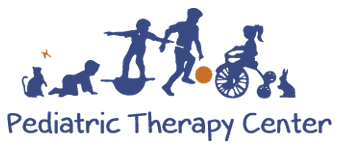Speech Therapy and NDT: NDT Series Part 4
Speech Therapy and NDT
Our fourth NDT therapist interview is with Claire Rosenkild, one of Pediatric Therapy’s speech and language pathologists, on how her new training influences her treatment.
**This interview has been lightly edited for length and clarity.
Miss our other posts? Click here for our introduction to NDT, here to learn about NDT in physical therapy, and here to learn more about occupational therapy.
Q: Why did you decide to take the NDT course?
I’ve been talking to Nancy Burford (SLP and one of the owners of PTC) about it since I started here. She’s always talked about the importance of taking the NDT course and getting the right instructor; it just took until this point to get it figured out. I think as therapists we always want to be prepared and capable to see whoever and I never wanted to have the feeling of someone walking in and I’m like “Oh my gosh, I’m not the best therapist for this kid!” It’s important to me to take every opportunity to expand in every way. So when I saw other therapists using NDT I felt like I was missing out on something I could take advantage of.
Q: Can you describe what NDT looks like when you use it during speech therapy?
That’s tricky. I remember talking to the speech instructor about balancing new moves and helping the child move or get positioned in certain ways that we can also bring back to their issues with speech or feeding.
To do that, I try to set up the room in a purposeful play manner. The kids have no idea they’re working but they also have to move around and do tasks that require them to engage their bodies.
Q: How does that help with speech issues specifically?
A lot of times we, as speech therapists, look at symptoms and what a kid comes in for and we treat that. And incorporating the NDT helps us answer the “but why” of the problem instead of just treating the symptom. If a kid comes in with secretion or feeding issues, in the past I would think it’s an issue solely with their mouth and that I need to start there. Now that I’ve done the NDT course I ask myself, but why are they doing that? Is it because they’re positioned a certain way? And if so how I can work on engaging their body and repositioning them in order to help them succeed in their goals.
We get trapped in bubbles as therapists and you think these are my goals and what I want them to be able to do within my bubble of experience and expertise. Through NDT I’ve learned to look at things differently and realize things I do in my session can help with speech and feeding but also a little one isn’t going to come here and not want to walk, so now with my awareness of their body I can help the child reach all of their goals instead of just mine
Has it changed how you treat your patients?
It changes how I look at everybody, and they taught us to look at the whole child so that you don’t get stuck treating each diagnosis a certain way. Everybody who comes in is different, so therapists need to learn how to think outside of box. If I do all the work I can do on their mouth and their body is still not working in conjunction with it, it’s not going to work unless it all comes together.
Q: Which patients do you use NDT with the most?
I try to use some part of it with everyone, especially when I have an evaluation because now I’m looking at them differently. But I do use it most with more neurologically involved kids. I also use it with a lot of patients with a lower arousal rate because once I get them moving then they come alive for the rest of the session.
Q: Any parting thoughts?
I think especially for speech NDT is not as broadly advertised and not a thing a lot of speech and language pathologists do. I’ve told all my friends to do it. I think that the course might discourage people because it’s more out of the speech comfort zone but to me that’s more of a reason to do it because otherwise we’re missing something.
I’m excited about the intensives and getting the opportunity to work closely with the physical and occupational therapists to help patients achieve goals in gross and fine motor skills as well as speech and language.
For more information on the NDT intensive camps or to set up an appointment, call us at 713.772.1400 or visit our homepage.




